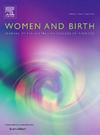The Continuity of Care Experience in Australian midwifery education – Where are we heading now?
IF 4.4
2区 医学
Q1 NURSING
引用次数: 0
Abstract
Problem or background
The Continuity of Care Experience (CoCE) is a mandated practice-based learning model for all pre-registration midwifery students in Australia. Evidence confirming the value of the learning experience continues to grow, and recommendations for improving the learning model have yet to be addressed using a standardised approach.
Aim
This integrative review provides an updated synthesis of the literature detailing the outcomes of the CoCE as an educational model since a previous review published in 2017.
Methods
This updated review replicated the methods used in the original review, including the search strategy, screening, extraction, and synthesis of newly identified studies. The results were synthesised to determine alignment with previous themes and identify emerging themes relevant to the midwifery student CoCE.
Findings
Since the original search, 29 additional publications were identified. The themes were consistent with the original review, with the addition of two new themes with five sub-themes, including clarifying the value of CoCE and recommendations to optimise learning.
Discussion
The CoCE's value is increasingly recognised as a critical inclusion in midwifery curricula. Adopting a coordinated approach to integrate the CoCE into core curriculum design, prioritising practice-based learning, and adopting standardised learning objectives and outcomes will overcome challenges and optimise the learning.
Conclusion
This updated review confirmed that the CoCE is a unique and valuable learning model that fosters woman-centred care. Implementing the key recommendations from internationally published research can significantly enhance midwifery education and prepare a future workforce capable of providing woman-centred care to improve women's outcomes.
求助全文
约1分钟内获得全文
求助全文
来源期刊

Women and Birth
NURSING-OBSTETRICS & GYNECOLOGY
CiteScore
7.20
自引率
13.20%
发文量
371
审稿时长
27 days
期刊介绍:
Women and Birth is the official journal of the Australian College of Midwives (ACM). It is a midwifery journal that publishes on all matters that affect women and birth, from pre-conceptual counselling, through pregnancy, birth, and the first six weeks postnatal. All papers accepted will draw from and contribute to the relevant contemporary research, policy and/or theoretical literature. We seek research papers, quality assurances papers (with ethical approval) discussion papers, clinical practice papers, case studies and original literature reviews.
Our women-centred focus is inclusive of the family, fetus and newborn, both well and sick, and covers both healthy and complex pregnancies and births. The journal seeks papers that take a woman-centred focus on maternity services, epidemiology, primary health care, reproductive psycho/physiology, midwifery practice, theory, research, education, management and leadership. We also seek relevant papers on maternal mental health and neonatal well-being, natural and complementary therapies, local, national and international policy, management, politics, economics and societal and cultural issues as they affect childbearing women and their families. Topics may include, where appropriate, neonatal care, child and family health, women’s health, related to pregnancy, birth and the postpartum, including lactation. Interprofessional papers relevant to midwifery are welcome. Articles are double blind peer-reviewed, primarily by experts in the field of the submitted work.
 求助内容:
求助内容: 应助结果提醒方式:
应助结果提醒方式:


